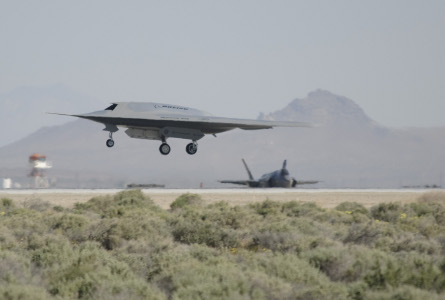First flight of the Boeing Phantom Ray on 27 April cleared a critical step in the company's search for external funding, but no obvious fiscal streams have appeared on the horizon for the stealthy unmanned combat air vehicle (UCAV).
The 17min flight from Edwards AFB, California, was long enough for the X-45C-based Phantom Ray to open the flight envelope to an altitude of 7,500ft (2,290m) and a speed of 178kt (330km/h).
The company still plans to complete 10 self-funded test flights of the Phantom Ray by the end of June, but internal cost pressures could end the programme sooner.
 |
|---|
© Boeing |
Since mid-2007, Boeing has used company funds to launch the Phantom Ray, reviving the X-45C concept set adrift when the joint unmanned combat air systems (J-UCAS) programme was cancelled in 2006.
A year later, the Northrop Grumman X-47B defeated Boeing's bid for the US Navy's programme to demonstrate a carrier-based, stealthy UCAV.
 |
|---|
© Boeing |
Suddenly, Boeing had no access to a non-classified programme of record in the slowly-emerging stealthy UCAV market. Its position became even more precarious with the revelation in late 2009 of the Lockheed Martin RQ-170 Sentinel, another stealthy UCAV that has already been deployed operationally by the US Air Force.
Boeing formally unveiled the Phantom Ray demonstrator last year. On 13 December, the aircraft was flown on top of the Boeing 747 shuttle carrier aircraft to Edwards. Taxi tests were completed on 30 March, but steady high winds delayed first flight for another three weeks, Brown said.
 |
|---|
© Boeing |
Although no official observers outside Boeing and its suppliers witnessed it, the first flight event was monitored closely by a host of potential customers. But proving the Phantom Ray could fly was a key test in Boeing's marketing campaign, Brown said.
The initial flight test is now "percolating among those customer communities," he said, adding that Boeing expects that expressions of interest will become more serious.
But the programme will likely have to survive as a testbed for other programmes, with no new requirements for a new, land-based, stealthy UCAV on the horizon.
Source: Flight International























